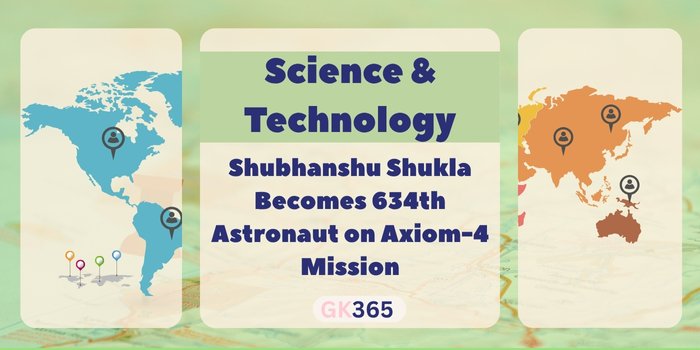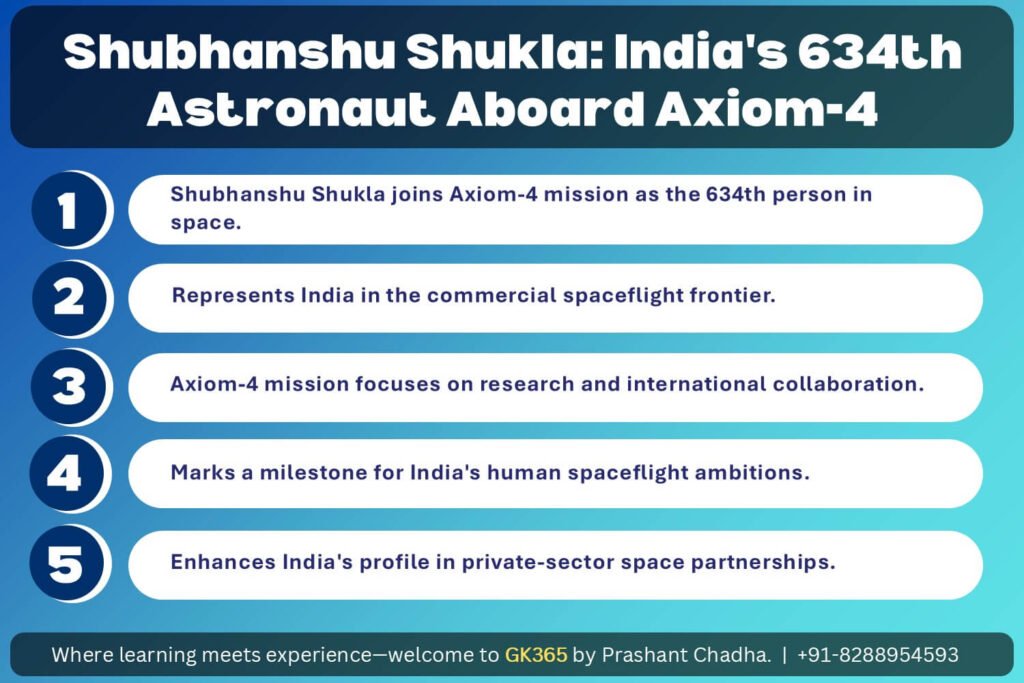Introduction
On June 26, 2025, Group Captain Shubhanshu Shukla of the Indian Air Force became the 634th person to enter space. He docked with the International Space Station (ISS) as part of the Axiom-4 mission. His 14-day stay marks India’s growing presence in international space efforts. The mission highlights India’s progress in astronaut training and its deeper role in global space projects like the upcoming Gaganyaan mission.
Shukla’s flight signals both capability and inspiration. It shows India can support astronauts for joint missions and sparks interest among young Indians in science and space.
🧭 Table of Contents
- Overview of the Axiom-4 Mission
- Meet the Multinational Crew
- Objectives of the Axiom-4 Mission
- India’s Growing Role in Space Diplomacy
- What Shubhanshu Shukla Said from Space
- Celebrations Across India
- Comparing India’s Space Journey with Global Programs
- FAQs on Axiom-4 and India’s Role in Space
- Suggested Links
- Conclusion: A Proud Moment for Indian Space Aspirations
- Key Takeaways Table
🚀 Overview of the Axiom-4 Mission
- Mission Name: Axiom-4 (Ax-4)
- Launch Date: June 25, 2025
- Docking with ISS: June 26, 2025
- Duration: 14 days
- Launch Vehicle: SpaceX Crew Dragon
- Organized by: Axiom Space, U.S.A
- Destination: International Space Station (ISS)
Axiom-4 is a private, international mission. It brings astronauts from different countries together to conduct experiments in space. The flight supports research in microgravity and encourages commercial space access.
👨🚀 Meet the Multinational Crew
- Peggy Whitson (USA): Mission Commander and veteran NASA astronaut
- Shubhanshu Shukla (India): Indian Air Force Group Captain
- Sławosz Uznański (Poland): ESA reserve astronaut
- Tibor Kapu (Hungary): Space researcher studying health in space
This team reflects international cooperation in space missions.
🧪 Objectives of the Axiom-4 Mission
- Conducting microgravity experiments in biology, health, and material science
- Sharing research with global institutions
- Studying human adaptation across different ethnic and climatic backgrounds
- Engaging students in STEM through live outreach sessions
Shukla’s role adds an Indian perspective and inspires students toward science and space exploration.
🌍 India’s Growing Role in Space Diplomacy
Shukla’s spaceflight strengthens India’s ties in global space affairs. After Rakesh Sharma’s flight in 1984 and the achievements of Sunita Williams and Kalpana Chawla, Shukla continues India’s journey in human spaceflight.
His presence on Axiom-4 supports ISRO’s goals for Gaganyaan and reflects India’s growing collaboration with private players like SpaceX and Axiom Space.
📡 What Shubhanshu Shukla Said from Space
“I am astronaut 634. It is a privilege to be here.”
“I am carrying the Tiranga and I’m very confident that the next 14 days are going to be amazing.”
“This is also a phase of India’s space journey.”
“The view is amazing, but what surpasses it is the warmth of the crew at the ISS.”
🎉 Celebrations Across India
In Lucknow, Shukla’s hometown, celebrations took place across schools and colleges. Science groups held live sessions, and defense and space officials marked the moment as a milestone for India’s space ambitions.
🔍 Comparing India’s Space Journey with Global Programs
India’s role in Axiom-4 highlights its rise in the global space community. While the U.S., Russia, and China dominate, India is gaining ground through partnerships, cost-effective missions, and growing ambitions.
With Chandrayaan-3 behind it and Gaganyaan on the horizon, India has firmly entered the arena of international crewed spaceflight.
❓ FAQs on Axiom-4 and India’s Role in Space
- Who is Shubhanshu Shukla?
An Indian Air Force Group Captain, and the 634th astronaut to enter space in June 2025. - What is the Axiom-4 mission?
A private spaceflight by Axiom Space with astronauts from India, the U.S., Poland, and Hungary. - Why is this mission important for India?
It places India back into international crewed missions, building experience ahead of Gaganyaan. - What types of research are conducted?
Health studies, cell biology, and material science in microgravity conditions. - How is this connected to Gaganyaan?
Shukla’s participation strengthens India’s astronaut readiness and international partnerships for future missions.
🔗 Suggested Links
- Axiom Space – Official Website
- NASA – International Space Station
- SpaceX – Crew Dragon Overview
- ISRO – Human Spaceflight Program
🏁 Conclusion: A Proud Moment for Indian Space Aspirations
Shubhanshu Shukla’s trip to the ISS is a milestone for India. It shows how the country is combining defense training, scientific preparation, and global teamwork.
With missions like Gaganyaan on the horizon, this success builds momentum. It also motivates a new generation of students and professionals who want to contribute to India’s space future. The country is not just watching space missions—it is joining them.
Track India’s space missions, new discoveries, and global partnerships.
Read more updates and expert articles at GK365.in.
Key Takeaways Table
| Category | Details |
|---|---|
| Name | Group Captain Shubhanshu Shukla, Indian Air Force |
| Achievement | Became the 634th person to go to space; docked with the ISS as part of the Axiom-4 mission on June 26, 2025 |
| Mission | Axiom-4 (Ax-4) – a private international mission organized by Axiom Space (USA) using SpaceX Crew Dragon |
| Mission Duration | 14 days aboard the International Space Station |
| Crew Members | – Peggy Whitson (USA) – Commander- Shubhanshu Shukla (India)– Sławosz Uznański (Poland)– Tibor Kapu (Hungary) |
| Mission Objectives | – Conduct research in microgravity- Study human physiology across diverse backgrounds- Engage youth in STEM outreach |
| Significance for India | – Advances India’s astronaut training- Supports Gaganyaan preparation- Boosts global space diplomacy and partnerships |
| Inspirational Quotes from Space | “I am astronaut 634… carrying the Tiranga.”“This is also a phase of India’s space journey.” |
| Public Response | Celebrations in Lucknow, national coverage, and widespread enthusiasm in science and defense communities |
| Historic Context | Follows legacy of Rakesh Sharma (1984), Kalpana Chawla, and Sunita Williams |
| Strategic Relevance | Builds astronautic experience for ISRO, strengthens ties with SpaceX and Axiom Space, and positions India as an emerging space leader |
| Connection to Gaganyaan | Supports astronaut training and readiness for India’s first crewed mission, targeted for upcoming years |



